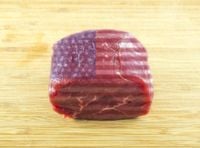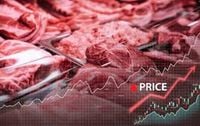American consumers are grappling with soaring beef prices that have reached historic highs across the country, with ground beef and steak leading the surge. In Boston, for example, the price of ground beef per pound has climbed to about $9 in July 2025, a sharp 29 percent increase from around $7 in January, according to a Globe analysis of Datasembly data. This price escalation reflects a broader national trend driven by a complex interplay of shrinking cattle herds, persistent drought conditions, elevated feed costs, and tightening global trade dynamics.
According to the U.S. Bureau of Labor Statistics, beef prices have jumped nearly 9 percent since January 2025, retailing at an average of $9.26 per pound. The June 2025 Consumer Price Index further underscored this trend, showing steaks up 12.4 percent and ground beef up 10.3 percent compared to the previous year. These figures highlight a relentless upward trajectory in beef costs that experts warn will persist well into 2026 and possibly beyond.
At the heart of this price surge lies the shrinking U.S. cattle herd, which stood at 86.7 million head as of January 1, 2025—the lowest level since 1951. This decline is largely attributed to multiple years of drought across key agricultural regions, which have severely dried up the crops that cattle typically consume. As Derrell Peel, a professor of agricultural economics at Oklahoma State University, explained, "We’ve had multiple years of drought that have pulled cattle inventory down to multi-decade lows. You don’t turn it around very fast and it has to get worse before it gets better." His assessment reflects a grim reality for cattle producers who face a slow and challenging path to herd rebuilding.
Adding to the strain are elevated feed costs, which have pushed profit margins for cattle farmers and ranchers to razor-thin levels. Bernt Nelson, an economist for the American Farm Bureau Federation, noted that despite record-high beef prices, producers are squeezed by persistent supply expenses. Ranchers also face difficult decisions about whether to sell animals now at high prices or hold onto them for longer-term productivity. David Anderson, a livestock economist at Texas A&M, summarized this dilemma: "For them, the balance is, ‘Do I sell that animal now and take this record high check?’ Or ‘do I keep her to realize her returns over her productive life when she’s having calves?’"
Compounding domestic challenges are disruptions in beef imports, which have historically supplemented U.S. supply. Earlier in 2025, the U.S. Department of Agriculture suspended imports from Mexico due to the emergence of the New World Screwworm, a flesh-eating parasite affecting Mexican cattle. This suspension disrupted a supply line that accounts for roughly 4 percent of U.S. slaughter cattle. Additionally, looming trade tensions threaten to tighten supply further. A new 50 percent U.S. tariff on Brazilian beef imports, effective August 1, 2025, risks disrupting global supply chains. Brazil currently provides about 23 percent of U.S. beef imports, and the tariff has already caused Brazilian exporters to reconsider shipments.
Imported beef from countries such as Argentina, Australia, and Brazil now accounts for approximately 8 percent of U.S. beef consumption, a significant share that may shrink if trade barriers persist. Meanwhile, U.S. beef exports have declined, dropping 22 percent in May 2025 compared to the same month the previous year, reflecting shifting global market dynamics.
Despite these price pressures, American demand for beef remains robust. The Associated Press quoted Kansas State agricultural economist Glynn Tonsor, who highlighted that it is the height of grilling season and consumer enthusiasm for beef endures. Interestingly, while prices have soared, consumers have not broadly shifted to alternative proteins like chicken or pork, nor have they significantly altered their preference within beef categories. Josh Funk of the AP observed, "If prices remain this high, shoppers will likely start to buy more hamburger meat and fewer steaks, but that doesn’t appear to be happening broadly yet — and people also don’t seem to be buying chicken or pork instead of beef." This resilience in demand underscores the cultural and culinary significance of beef in American diets.
Retailers are responding to these challenges with innovative strategies. Walmart, for instance, recently opened its first wholly owned and operated beef facility in Olathe, Kansas. This move aims to reduce supply chain costs by working directly with suppliers, potentially easing some price pressures for consumers. However, experts caution that such measures may only provide limited relief in the near term.
Michael Swanson, chief agriculture economist at Wells Fargo, described the beef market as the "Wild West" of the protein sector, contrasting it with the more predictable and managed egg market. He emphasized the complexity of beef production and supply, noting that "nobody wants to be caught holding the bag with higher-priced cattle when cattle prices start to decline, which they will inevitably." Swanson and other economists agree that significant moderation in beef prices will likely depend on a decrease in consumer demand, which could be triggered by waning consumer confidence or broader economic uncertainties.
Looking ahead, the USDA's July 2025 report predicts that beef prices will continue to rise through 2025 and 2026 before slowly declining, though still remaining somewhat elevated compared to previous years. This outlook aligns with the consensus among agricultural economists that the current situation is unlikely to improve quickly. Derrell Peel cautioned, "It might be at least two to three years before we would see any significant change on the supply side that would ultimately lead to some moderation in beef prices."
In summary, American consumers are facing a perfect storm of factors driving beef prices to record highs: historically low cattle herd sizes, persistent drought and feed cost challenges, disrupted import channels, and escalating trade tensions. While demand remains strong and retailers seek solutions, experts warn that relief is a distant prospect. For now, shoppers may have to brace themselves for continued sticker shock at the meat counter as the cattle industry navigates these turbulent times.





